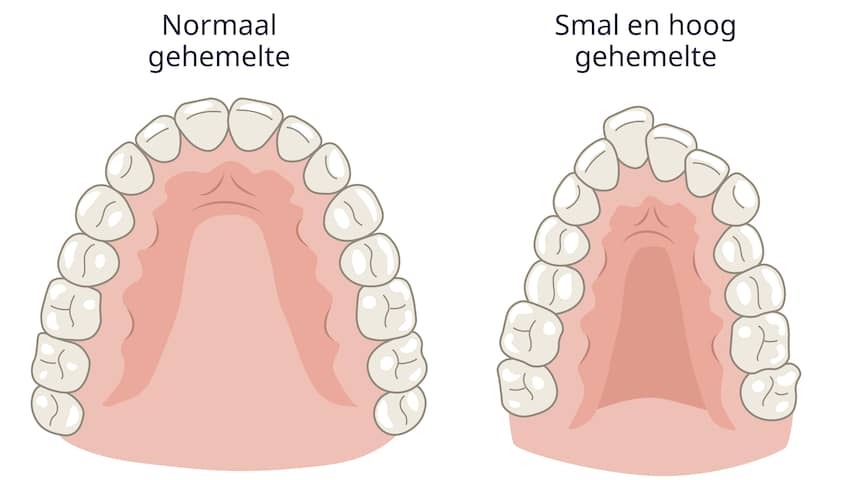
Many parents find it difficult to take the teat of their child, because that object often brings peace immediately. Understandably, these Mondexperts say: but you do condemn your child to a narrow teat bawcie, a bracket or a speech lack of speech.
A ball of teat, a flat, round, thin or thick: it doesn’t matter. After about nine months it has to stop, Melek ATAS tells Nu.nl. She is a dental hygienist and wrote an assistant book for parents: help, my child gets teeth!
Your child has no choice, but has to deal with a too narrow jaw, Scottish and crooked teeth, any speech problems and later also valuable and painful orthodontist treatments. “Many parents grab a teat to comfort their baby, and that is also very understandable. Yet it is good to know that long -term use of a teat can influence the development of teeth and jaw.
After about nine months you can consider reducing the teat slowly, she says. “That can later prevent speech problems and orthodontic procedures. It is a small step that means a lot for the future of your child. Yes, your child sits quietly in the pram, for the TV or in the car seat so that you have a rest. But a teat is for an infant and that is your baby after nine months really not ok.”
A teat also has proven benefits
Yet they are in every supermarket: teats for 18, 24 or 36 months. That is a simple case of supply and demand, Preverbal explains speech therapist and lactation consultant Maaske Treurniet. But a teat is a tool for those first months in which babies still have a strong suction requirement. “Then a teat has proven benefits. It has an analgesic, calming, comforting, it can help to learn to drink premature babies and even a connection has been shown to prevent cot death.”
But your baby is growing, the mouth too and with six months they can chew, play toys in their mouths and the suction reflexes decrease. A teat that is always on the tongue and pushes the jaws apart, only has disadvantages. “The tongue should be at the top of your palate, and the jaws closed. This way a beautiful, wide jaw can grow. But if the tongue is always pushed down and the jaw is always open, the palate will grow narrower and higher.”
Hanging jaw and wrong swallowing
A child then develops a narrow upper jaw in which there is insufficient space for coming teeth. “You can recognize such a mouth when you see it. The upper jaw is narrow, with a point forward, such as the bow of a boat. That should be a wide round arch. In such a narrow nozzle, the teeth grow skewed. Because the jaw is open and because of that low tongue position, a child can also swallow wrong.”
The tongue is always pushed against the teeth by that abnormal. Your tongue is a strong muscle, says Treurniet, and because of the power of swallowing the teeth can stand crooked and a hole can form between the teeth in the middle, where the tongue hangs a bit. “This way, children can rather slip. The T, L and S sounds are then made with the tongue out, instead of against your palate.”
A sliceing child may sound cute, but it is no longer when you are an adult. Your tongue hangs out of your mouth and you hurt enormously, says Treurniet.
Let children chew and grind
It also has disadvantages for dental hygiene, ATAS explains. “With such a narrow upper jaw the adult teeth have less space. They will grow crooked, making it more difficult to brush well and keep them clean.”
So get that teat out of that mouth as quickly as possible. That is not easy, because the habituation is really huge after about two or three years. “You can’t blame such a child,” says ATAS “The teat has dragged him through everything. It gives peace, relaxation and a nice feeling.”
Compare it a bit with smoking. Stubborn smoke addicts are not only crazy about that cigarette, but also at the times they link to smoking: at the coffee, at a party, after a tough working day. “This is how the teat belongs to the place of sleeping, when they are in the car, when they go for a walk when they are sad when they watch TV,” says Treurniet. “That is all together a very large part of the day.”
If you find it too difficult to put the teat Cold Turkey away, reduce the moments. “Do not put the teat in the mouth as standard in a car ride,” says Treurniet. “And when your child is sleeping, remove the teat and close the mouth.”
Children must learn to chew and grind them with their jaws; So give them a bread crust instead of a teat from about six months. Or toys, teething and later pieces of carrot or hard raw vegetables. “Vary with hard, soft, warm, cold. This is how you strengthen the mouth motor skills and challenge the chewing muscles.”
The longer you wait, the more damage you cause, and the more difficult the fight becomes. “When they are over one year, it is already a stubborn habit,” concludes ATAS. “Children about three years old are smart. They are going to negotiate, get tantrums, are very dependent on that thing. Get the teat before they are one year.”
Many Parents Find It Difficult to Take AWAY Their Child’s Pacifier, Because that object of Brings Immediate Peace. Understandable, Say these Oral Experts: But You Are Condemning Your Child to A Narrow Pacifier Mouth, Braces or A Speech Impediment.
A Round Pacifier, A Flat, Round, Thin Or Thick One: It Doesn’t Matter. After about Nine Months It Has To Stop, Melek Atas Tells Nu.nl. She is a dental hygienist and wrote a help book for parents: help, my child is teething!
Your child has no choice, but has to deal with a jaw that is too narrow, crooked teeth, possible speech problems and later also costly and painful orthodontist treatments. “Many Parents Reach for a pacifier to comfort Their Baby, and that is very understandable. However, it is good to know that prolonged use of a pacifier can influence the development of teeth and jaw.
After about Nine Months, You Can Consider Slowly Weaning Off The Pacifier, She Says. “That can prevention speech problems and orthodontic procedures later on. It is a small step that means a lot for your child’s future. Yes, your child sits still in the stroller, in front of the TV or in the car seat so that you have a pave of mind. Nine Months.
A Pacifier also has Proven Benefits
Yet They Are in Every Supermarket: Pacifiers for 18, 24 OR 36 Months. That is a Simple Case of Supply and Demand, Explaains pregal speech therapist and lactation consultant Maaske Treurniet. But a pacifier is a tool for those first months in which babies still have a strong sucking need. “Then a pacifier has Proven Benefits. It works pain-relieving, calming, comfilling, it can help premature babies Learn to drink from the breast and there has just a link shown with the prevention of surden infant death syndrome.”
But Your Baby Grows, The Mouth Too and At Six Months They Can Chew, Put Toys in Their Mouth and the Sucking Reflexes Decrease. A pacifier that then lies on the tongue and pushes the jaws separate only has disadvantages. “The Tongue Should be Lying at the Top Against Your Palate, and the Jaws Closed. This Allows a Beautiful, Broad Jaw To Grow. But If The Tongue Is Constantly Pushed Down And The Jaw Is Constantly Hanging Open, The Palate Will Grow NarrowWower and Higher.”

Open Hanging Jaw and Wrong Swallowing
A child then developops a narrow upper jaw in which there is insufficient space for incoming teeth. “You recognize Such a mouthh when you see it. The upper Jaw is narrow, with a point forward, like the bow of a boat. That should be a wide, round arch. In Such a narrow pacifier mouth, the teeth tonge low -to -down low -to -down. Can also start swallowing incorrectly. “
Because of that abnormal swallowing, the tongue is constantly pushed against the teeth. Your tongue is a Strong Muscle, Says Treurniet, and Due to the Force of Swallowing, The Teeth Can Become Crooked and a Gap Can Form between the Teeth In the Middle, Where the Tongue Hangs Out A Bit. “This way children can start lisping soner. You then make the t, l and s sounds with the tongue outward, Instead of Against Your Palate.”
A lisping child May sound cute, but it is no longer when you are an adult. Your tongue hangs out of your mouth and you lisp huge, accordance to treurniet.
Let Children Chew And Grind
It also has disadvantages for dental hygiene, explains atas. “With such a narrow upper jaw, the adult teeth have less space. They will grow crooked, making it more diffress to brush coperly and keep them clean.”
So get that pacifier out of that mouth as soon as possible. That is not easy, because the habitation is really huge after about two, three years. “You can’t blame that child for that,” Says Atas. “The Pacifier has dragged Him through Everything. It gives peace, relaxation and a nice feeling.”
Compare it a bit with smoking. Hardcore Smokers Are Not Only Fond of that Cigarette, But also of the Moments They Associate With Smoking: With Coffee, At A Party, After A Hard Day At Work. “That’s how the pacifier for children belongs to the sleep moment, when they are in the car, when they go for a walk, when they are sad, when they watch TV,” Says treurniet. “That is all together a very large part of the day.”
If you find it too difficult to get rid of the pacifier cold turkey, reduce the moments. “Don’t put the pacifier in the mouth by default duration a car ride,” Says Treurniet. “And when your child sleeps, remove the pacifier and close the mouth.”
Children must learn to chew and gravel with their Jaws; So give them a crust of bread from about Six Months Instead of A Pacifier. Or toys, teething rings and later pieces of carrot or hard raw vegetables. “Vary with hard, soft, warm, cold. This strengths the oral motor skills and challenges the chewing muscles.”
The Longer You Wait, The More Damage You Do, And The Harder The Battle Becomes. “If they are about one year old, it is already a persistent habit,” concludes atas. “Children of About Three Years Old Are Smart. They will negotiate with you, Have Tantrums, are extremely Dependent on that thing. Remove the Pacifier Before they are one year old.”